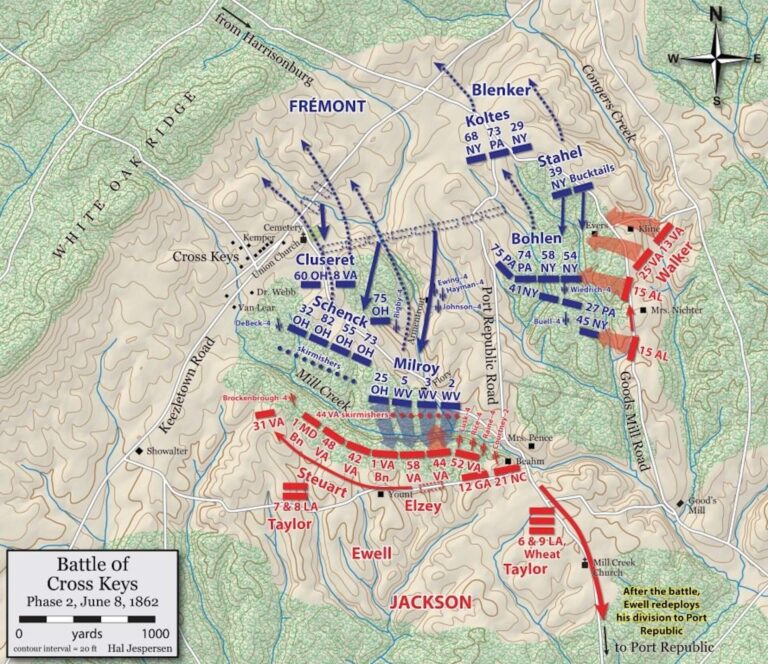The Battle of Cross Keys took place on June 8, 1862, and was to be the penultimate battle in Jackson’s Valley Campaign. Along with the Battle of Port Republic, fought the very next day, the battle would prove decisive.
Located in Rockingham County, Virginia, the Cross Keys battlefield is today preserved by the American Battlefield Trust, an area of 533 acres. Notable sites are the Artillery Ridge (where Confederate forces had stationed themselves) and a church that acted as a hospital following the battle.
From March of 1862, Gen. Stonewall Jackson had been marching his troops across the Shenandoah Valley at an impressive speed and with an ease that could only dishearten Union forces.
Following his March 23 defeat at the Battle of Kernstown, Jackson enjoyed a run of military victories. This Confederate success was what prompted the Union generals Frémont and Shields to attempt to attack Stonewall’s men from the northeast and northwest.
However, being aware of this looming threat, Stonewall Jackson laid out plans to attack the two Union armies before they could group themselves at Port Republic.
Jackson and his men set up an encampment at the Port Republic, taking control of the North Bridge in the process; this was the last remaining bridge that spanned the Shenandoah River.
Confederate Gen. Ewell, meanwhile, was instructed to go to Cross Keys to engage Frémont to halt his advance or defeat him outright. Frémont, on the other hand, had his own plans to envelop the Confederate battalions.
It was Sunday, 8 June 1862, when the Union and Confederate armies would meet at Cross Keys. Frémont’s forces totaled around 11,500, while those under the command of Ewell were only around 5,800, giving the Union army an almost two-to-one advantage.
This, though, was not to be the advantage that it could have been!
Frémont initially believed that Stonewall Jackson’s entire Confederate forces were stationed at Cross Keys, causing him to delay his attack and allow Ewell to fortify his position along what is today known as Artillery Ridge.
In fact, Stonewall Jackson had entrusted Ewell with the task of halting Frémont, and he never came closer than Mill Creek. This fact says a lot about Jackson’s faith in Ewell, for he was rarely comfortable delegating tasks.
After his halting start, Frémont decided to attack the Confederate forces’ right flank, where he thought they were weakest. This was to be a grave mistake.
A brigade led by Gen. Isaac R. Trimble had crouched low down along a ridge and caught Frémont’s forces off guard, hitting them with volley upon volley. The 8th New York Infantry Regiment (also known as Blenker’s Rifles), which was mainly made up of German immigrants, was decimated. Trimble was able to repel the Union forces all the way back to Keezletown Road.
Ewell’s Confederate troops, centered around Mill Creek, continued engaging in an artillery duel until Frémont withdrew his forces. The Confederate’s superior defensive positions and Trimble’s successful advances had prevented Frémont from mounting a coordinated attack.
In fact, as the day passed into night, Trimble’s troops continued pursuing the Union forces and got within a quarter mile of their positions at Keezletown Road.
Ewell, however, knew the battle had been won and recalled Trimble and his forces before any unnecessary risks were taken. After the battle, Union casualties totaled 557 killed and wounded and 100 captured, while the Confederates had 288 casualties, with only 41 deaths.
It was a victory for the Confederates, and having successfully pushed Frémont’s troops back, Ewell’s army could head south and join Stonewall Jackson in the fight against Shields.
Continue exploring the history of the American Civil War in Virginia with more of our Virginia Civil War Battlefield Guides.

Ready to explore the battlefield for yourself? Browse our full selection of American Civil War Battlefield Tours.
Please contact us if you have any questions about our tours or services.